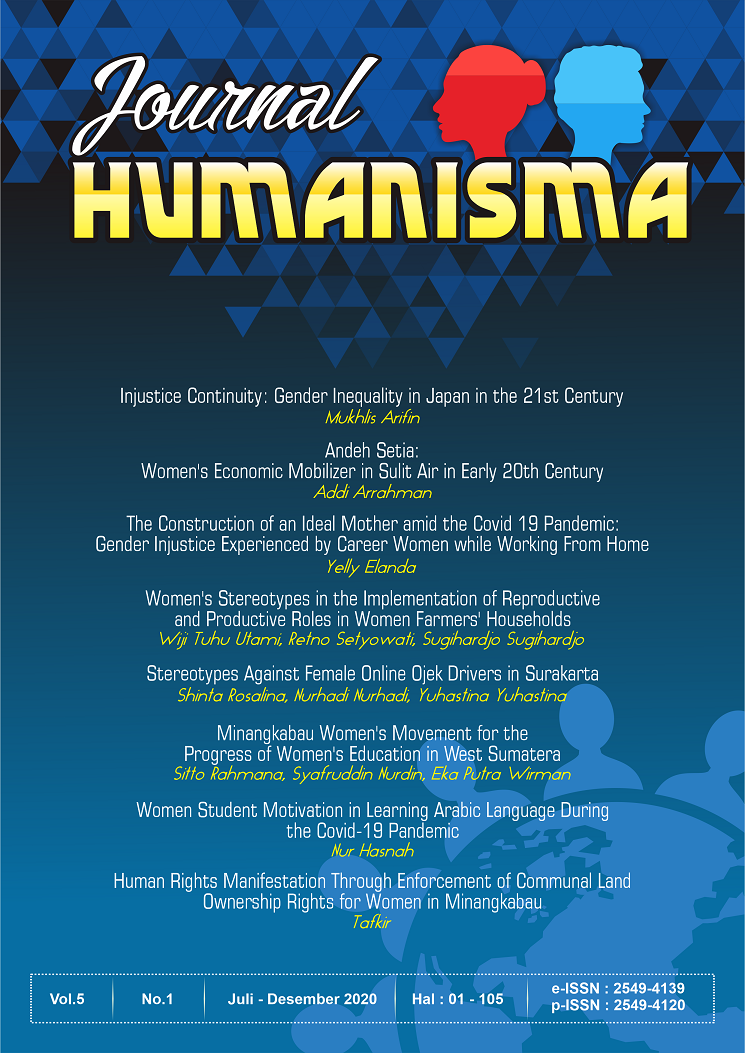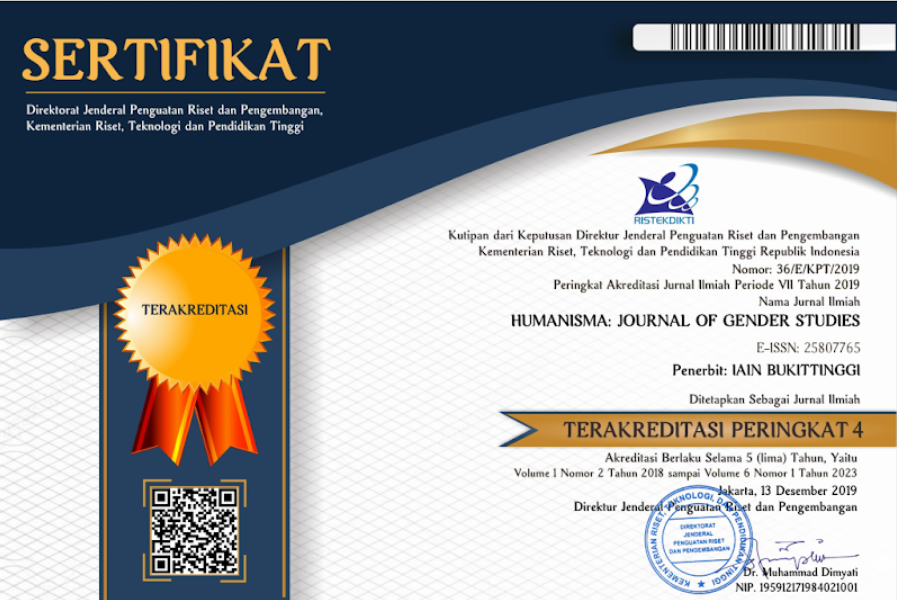ANDEH SETIA: Women's Economic Mobilizer in Sulit Air in Early 20th Century
DOI:
https://doi.org/10.30983/humanisme.v5i1.3675Keywords:
Andeh Setia, Weaving, Mahyuddin Dt. Sutan Maharaja, Women's Economy,Abstract
Weaving handicrafts became the motor Minangkabau's economy at the beginning of the 20th. It encouraged the establishment of weaving centers, such as Amai Setia (1911) and Andeh Setia (1912). Amai Setia handicrafts' are still standing strong nowadays, while Andeh Setia is thus no longer known by the people of Sulit Air today. This paper uses the social history approach and exposes the history of the emergence and fall of Andeh Setia as an economic movement in Sulit Air. The establishment of Andeh Setia is inseparable from the role of ninik mamak and women in Sulit Air. Andeh Setia's success was ultimately drowned due to the loss of driving figures, the reduction in women's interest in weaving crafts, and the overflow of merantau. This finding also suggests that the economic independence of the people in Sulit Air, depends heavily on the role of perantau. This situation is thus an obstacle to the realization of economic independence.Â
Â
Kerajinan tenun menjadi penggerak perekonomian di Minangkabau pada awal ke-20. Ini mendorong terbentuknya pusat kerajaninan tenun, seperti Amai Setia (1911) dan Andeh Setia (1912). Kerajinan Amai Setia hingga saat ini masih dapat ditemukan, sedangkan Andeh Setia justeru tidak dikenal lagi oleh masyarakat Sulit Air hari ini. Padahal, pada tahun 1912, kualitas tenun Andeh Setia sangat diminati pasar. Itulah sebabnya, Andeh Setia menjadi penggerak ekonomi perempuan di Sulit Air. Artikel ini juga menemukan bahwa sebab hilangnya Andeh Setia adalah karena kehilangan tokoh penggerak, menurunnya minat kaum perempuan terhadap kerajinan tenun, dan menguatnya arus merantau.
Â
References
Journal
Addiarrahman. A. “Ekonomi Kemakmuran Bersama: Indonesian Islamic Economic Thought of Kahrudin Yunus.†Shirkah: Journal of Economics and Business 3, no. 3 (10 Desember 2018). https://doi.org/10.22515/shirkah.v3i3.220.
Hanani, Silfia. “Ruhana Kuddus Pelopor Gerakan Entrepreneur Perempuan di Minangkabau.†Marwah: Jurnal Perempuan, Agama dan Jender 19, no. 1 (2020): 1–14.
Salmon, Claudine. “Presse féminine ou féministe ?†Archipel 13, no. 1 (1977): 157–92. https://doi.org/10.3406/arch.1977.1334.
Sari, Susi Ratna. “Dari Kerajinan Amai Setia Ke Soenting Melayoe Strategi Rohana Kuddus Dalam Melawan Ketertindasan Perempuan Di Minangkabau.†Kafaah: Journal of Gender Studies 6, no. 2 (2016): 235–250.
Book
Abdullah, Taufik. “Modernization in the Minangkabau world: West Sumatra in the early decades of the twentieth century.†Culture and politics in Indonesia, 1972, 179–243.
Adatrechtbundel XI: Sumatra, (‘S-Gravenhage, Martinus Nijhoff, 1915)
Amran, Rusli. Sumatra Barat Hingga Plakat Panjang. Sinar Harapan, 1981.
De Indische Courant, No. 233 Zaterdag 27 Juni 1931
De Locomotief, Vrijdag 24 Juni 1921.
Dobbin, Christine E. Gejolak ekonomi, kebangkitan Islam dan gerakan padri: Minangkabau 1784-1847. Jakarta: Komunitas Bambu, 2008.
Fitriyanti. Roehana Koeddoes Tokoh Pendidik dan Jurnalis Perempuan Pertama Sumatera Barat. Jakarta: Yayasan Jurnal Perempuan, 2001.
Graves, Elizabeth E. Asal-usul elite Minangkabau modern: respons terhadap kolonial Belanda abad XIX/XX. Yayasan Obor Indonesia, 2007.
Hamdullah Salim. Sejarah Perkumpulan Sulik Aia Sepakat (SAS). Jakarta: DPP SAS, 2017.
Hamdulllah Salim. Perayaan Hajasa (Hari Jadi Sulik Aia) 28 April 1821. Jakarta: CV. Nusantara Printing, 2018.
Het Ombilin-Kolenveld in de Padangsche Bovenlanden en Het Transportstelsel op Sumatra’s Wetkust, Batavia : Landsrukkerij, 1907
Hindia Baroe, No. 77, Tahoen X, Sabtoe 3 April 1926
Natuutkundig Tijdschrift voor Nederlandsch Indie uitgegeven Door de Natuurkundige Vereeniging in Nederlandsch Indie, Batavia, Lange & Co: 1854
Nieuwe Amsterdamsche Courant Algemeen Handelsblad, Woensdag 25 September 1912
Nieuwe Rotterdamsche Courant, No. 258, Maandag 17 September 1860
Noer, Deliar. Gerakan Modern Islam di Indonesia 1900-1942. Jakarta: LP3ES, 1985.
Soenting Melajoe No. 34, Hari Djoema’at 22 Augustus 1913
Soenting Melajoe, No. 1, Hari Sabtoe, 4 Janoeari 1913
Soenting Melajoe, No. 15, Hari Sabtoe 12 October 1912
Soenting Melajoe, No. 17 Hari Chamis 17 April 1913
Soenting Melajoe, No. 3., Hari Chamis 15 Januari 1913
Soenting Melajoe, No. 4., Hari Sabtoe 27 Juli 1912
Soenting Melajoe, No. 6, Hari Sabtoe 10 Augustus 1912,
Sumatra Bode, Zaterdag 11 Juni 1921
Verbeek, R.D.M., Topographische en Geologische Beschrijving van een Gedeelte van Sumatra’s Westkust, Batavia: Landsdrukkerij, 1883
Yunus, Kahrudin. HÄd̲ihi hiya IndÅ«nÄ«siyÄ: risÄla Ê»ilmiyya Å¡Ämila Ê»an IndÅ«nÄ«siyÄ al-muǧÄhida. Mesir: al-Syabkasyi Press, 1947.
———. Sistem Ekonomi Kemakmuran Bersama, Djilid I. I. Jakarta: Fikiran Baru, 1955.
———. Sistem Ekonomi Kemakmuran Bersama, Djilid II. II. Jakarta: Fikiran Baru, 1956
Downloads
Published
How to Cite
Issue
Section
Citation Check
License
Authors who publish with this journal agree to the following terms:
- Authors retain copyright and grant the journal right of first publication with the work simultaneously licensed under a Creative Commons Attribution-ShareAlike 4.0. that allows others to share the work with an acknowledgment of the work's authorship and initial publication in this journal.
- Authors are able to enter into separate, additional contractual arrangements for the non-exclusive distribution of the journal's published version of the work (e.g., post it to an institutional repository or publish it in a book), with an acknowledgment of its initial publication in this journal.
- Authors are permitted and encouraged to post their work online (e.g., in institutional repositories or on their website) prior to and during the submission process, as it can lead to productive exchanges, as well as earlier and greater citation of published work (See The Effect of Open Access).



